
CHAPTER 10
UNSHACKLE YOUR MIND
AFRIKANS TAUGHT THE GREEKS SCIENCES
by
John Moore
These ancient Egyptian mummies, Egyptian temples, and many other aspects of the ancient Egyptian world are being shown because it was the Egyptian or Nile Valley civilization that had laid the foundation for the works of people like Sir Isaac Newton, Rene de Carte, Galileo, Copernicus, Keppler and many other European scientists. That Sir Isaac Newton in particular, acknowledged the debt he owed to the ancient Egyptian scientists is probable nothing new, but that these ancient Egyptians were Black like the other Afrikans, is something that most of us were unaware of.
With the modern belief of the inferiority of the Black skin, it will no doubt be unsettling for many to learn that philosophy, religion and science were nursed at the breast of Black Afrikans. Any creditable history book will show that when the Afrikans along the Nile Valley were creating high tech cultures, Greece did not exist and Europe was simply an insignificant dot on the map. Incidentally, it is an interesting delusion of modern understanding to recognise the current ruins of a fallen Greece as monuments of European greatness, while at the same time the destruction of the fallen Afrikan world is viewed as just an ancient ghetto.
In this section will be provided among other things, further evidence of the strong Afrikan influence on Europe.
This is part of a tour group in Aswan near the Egyptian and Nubian border. They are walking on top of an obelisk, the Greek name, but known to the ancient Egyptians as Tekhenu. This obelisk was going to be the largest monument of its kind to be ever built at the request of Queen Hatshepsut, the famous queen who built her temple in the Nile Valley. She tried to dwarf everything that any king had done before, and was about to do it again when the Tekhenu broke, so it was never completed because of the crack or flaw in it.
These monuments currently appear in major population centres all over the world. There is one in London on the banks of the Thames River, and another in central park New York.
There is also the pink granite Obelisk of Luxor which is located at the eastern end of the Champs Elysees called the Place de la Concorde (Square of Peace) in Paris.
This one is on St Peter's Square in the Vatican. In other words, there was a rush by heads of state and other officials all over the world to grab these Afrikan monuments.
The first Tekhenu on the left is located in Washington D.C but it is not an Afrikan one, but an imitation of the Afrikan Tekhenu (obelisk) better known as the Washington Monument. Next is an obelisk in Cairo, then the obelisk of Senwosret; and finally the obelisk of Rameses II.
At the bottom is a depiction of Tekhenus in the temple of Hatshepsut.
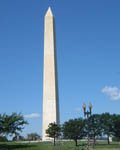
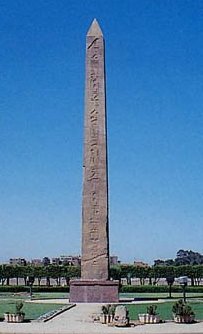

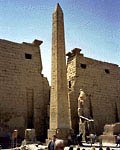
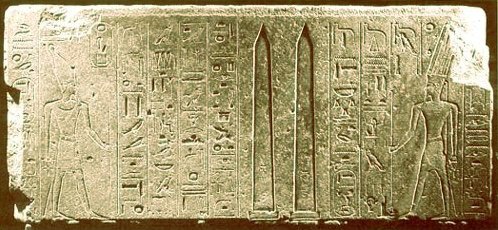
This is the Temple of Luxor as it was during the 18th dynastic period around 1500-1300 B.C., with columns that resemble trees and sometimes there is lotus or papyrus at the top. There are no records in Greece around that time period of architecture that resembles these. In fact, there was not even a Greece at that time or a Homer to write about Greece until around the 9th century B.C.
In the beginning the Greeks came to Afrika to visit, but they later returned to be educated before going back to Greece where they began imitating what they had learnt and seen on the Afrikan continent. One of the things they obviously learnt was Afrikan architecture, because that same form of architecture can be seen in Greece as identified in the picture on the left, and later in Post Offices and Federal Buildings in the United States. Americans imitate Greek architecture, but the Greeks were imitating Afrikan architecture, so whenever you visit Washington DC and see all those Federal Buildings, the Afrikan architects should be thanked for inspiring the Greeks and later on the other Europeans.
The mythology behind the Tekhenu goes back, according to one explanation, to the story of Isis and Osiris, where his evil brother Seth cut him into either 14 or, as some people say, 28 pieces. His wife Isis went around searching for those pieces until she finally collected all of them except one; the phallus (penis) of Osiris.
The Tekhenu (obelisk) is said to represent the penis of Osiris. The other parts were buried in different locations along the Nile Valley, and wherever they were buried, a temple was erected, but in place of the penis, a Tekhenu was erected to symbolize the creative power of Osiris.
Here is a diagram from the air of the Temple of Luxor. Underneath is the Louvre Museum in Paris. Parisians became fascinated with Egypt in 1798 beginning with Napoleon, and here the imitation of Afrikan architecture in this French architecture can be clearly seen.
If the name Paris is taken back to its roots and original meaning, it was called
The Place of Isis , named after the Egyptian Goddess - Pari Isidos. The most holy place in Paris is where the cathedral of Notre Dame is built. Notre Dame means Our Lady, but which Lady is being referred to? This of course is one of the titles of Isis, the Afrikan mother of Horus (Heru) and wife of Osiris (Asa). This religion had spread from Afrika all the way into Persia and Europe, and it was also very popular in Greece and Rome, later becoming popular in other parts of Europe including Paris.Pari Isidos was in recognition of the religious indebtedness of the French to the Afrikan religion, so it is not too hard to imagine that the connection between French architecture in its historical form and Afrikan architecture are so similar.
By the way, the name Europe may have been derived from a princess named Europa, and in the genealogical search and charts attested to by Ed Jones who wrote a book entitled "Profiles in Afrikan Heritage", Princess Europa was an Afrikan. In other words, the continent of Europe was named for an Afrikan Princess.
A dance major named Valerie Henry was interested in the connection between Ballet and Egyptian dance, since there are features which appear in the hieroglyphics in ancient Egypt that are similar to ballet.
For example, looking very closely at the top of the image there is a diagram showing how to perform the pirouette (pirouette), castanets, and so on.
The last outpost for native rule in Egypt was up the Nile Valley to Elephantine in Aswan, so named because of the shape of the rocks that resemble elephants. In other words, the Egyptians started from the south and then moved all the way to the north in order to establish their capital, thereby ruling from two places, the south and the north of the country. Later during the 18th dynastic period which was the new kingdom, they moved to the middle of the country, and the last time that native Afrikans were in control was in the 25th dynasty. This would be the time of the Ethiopian dynasty which came from Cush. They came through that whole area of Elephantine, but when they came under attack from Persia and later Greece, it seemed that they always had a haven near Aswan which was also the last site of what would be the headquarters of the Egyptian church and university.
The Egyptian university which was headquartered at Luxor at one stage had over 80,000 students that were in attendance. When that university declined, they retreated to the area around Aswan, and after the development of a strong Roman period and the development of the Christian church, the very last thing that was stamped out in the war on Afrikan culture was a little church at Philae Island located in the area of Aswan near Elephantine.
At Aswan there is a dam where a lake exists that extends some 450 miles from Egypt into Nubia, so part of that lake is in Egypt while the other part is in Nubia. This particular lake points to the water that has now covered 450 miles of the Nile Valley along where important Nubian towns were situated.
Remember the incense burner shown earlier? The site of the location of the nation of Ta Seti which that incense burner had pointed out is now under this water. In other words, many of the places where mummies and carvings could be dug up are now under the waters of Lake Nubia or Lake Nasser as some people call it. As a result, the whole Nubian population, the original Egyptian population, the people who looked most like the pictures that you have been seeing, was moved, and most of those Nubians were then brought into Egypt where they are now located in the towns of Kom umbo (Kom Ombo), Edfu (Idfu) and Aswan.
The ancient Egyptians saw themselves as a native Afrikan people, and even said that they came from the interior of Afrika. In other words, they came from the south at the sources of the Nile at the foothills of the Mountains of the Moon where the God Hapy (one of the four sons of Horus) lives. There are two Mountains of the Moon, Ruwenzori and Kilimanjaro. They never talked about the Tigris or Euphrates Rivers saying that they came from that area or that they had anything to do with the “sand dwellers” there, who they regarded as the enemy. They always saw their source at the interior.
For example, Hatshepsut sent an expedition to Punt which is present day Somali land, also known by the Egyptians at that time as the Holy Land. When she built the temple in the Valley of the Kings, it was an attempt to build a Punt in Egypt for God, because she thought that God would be most pleased if she could reproduce the homeland or the Holy Land in Egypt. So everything that we find about Egypt culturally, historically, linguistically etc., connects them directly to the interior of Afrika.
Everybody knows about King Tut because of the amount of jewellery found in his tomb, they know Nefertiti because of that one carving which is in the Berlin museum, they also know about Cleopatra, and Rameses II, one the most famous Pharaonic names of the 19th dynasty.
The important claim on antiquity that is being made here for native Afrikans in the Nile Valley are dynasties 1 to 12, 18 and 25. These are the major dynastic periods. All the other dynasties were heavily mixed with foreign populations including this dynasty that will be studied.
This is Rameses II who built a temple in a place called Abu Simbel which was also being covered over by Lake Nubia.
There was a rescue effort by the United Nations, the United States, and other European nations to help save these monuments by having them cut into parts as shown here, and then recreating them on a higher location further up the hill.
The picture below was taken outside the temple of Abu Simbel which was supposedly constructed by Rameses II. However, Rameses II had a habit of claiming things for himself that were built by other people. He would cut out the names of previous Pharaohs and inscribe his name on those carvings and structures, or even place a fence around a building and then claim that he built the entire structure.
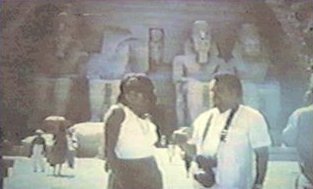
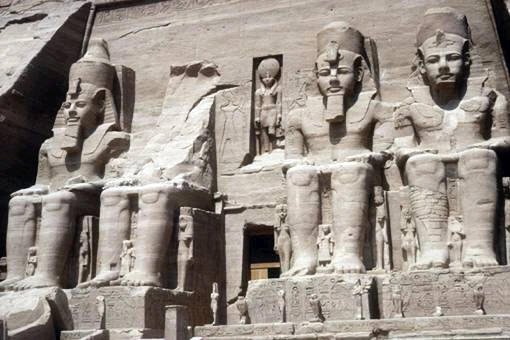
However, it is still possible to see those things that he did there in Abu Simbel on this temple. This is going down inside the interior of the temple (left) which has the four statues of Rameses II on either side. Looking deep down within the temple is the Holy of the Holies at the back (right), where once a day the sun which is called Ra would come into this holy temple. So the symbolism was that God visited the temple by means of that ball of sunlight which came in and bathed the statue of the King at the back who sat by the statue of the God Amon (the hidden God). This occurrence would take place on his birthday, where there would be a precise piercing of the inner temple, but when the temple was shifted, it is now off by one day. Even with all the computers and technology available, it just could not be recreated exactly as it was before. Here is one of the statues of Rameses II that was being face lifted and had some damage done to it.
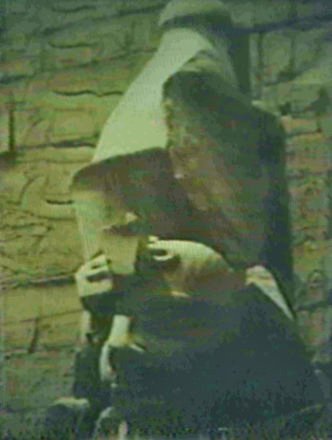
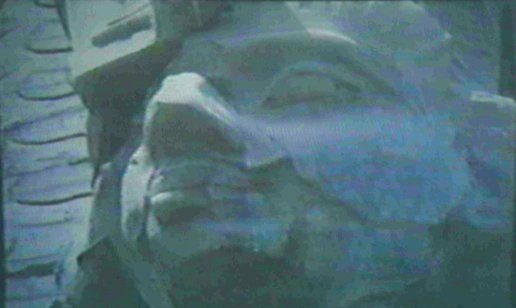
The damaged parts have been filled in, and while the face was being filled in, most of its Afrikan features were destroyed. The original statue clearly shows Rameses II to be a native Afrikan. Note the damage done to the statue which will not be noticed because it was filled in with a material to smoothen out the damaged areas, but in the process, the facial features have been altered enough to make him appear to be less Afrikan than he is here.
The Egyptians portrayed the races of mankind in the temple of Rameses III, where an Asiatic classification in addition to two Negroid types can be seen. One is Egyptian and the other is Nubian. The Egyptians made no physical distinction between themselves and the Nubians, either in this temple or in the tomb of Rameses III. The one on the left is supposed to be Nubian, and the one between the Semite and the Asian is supposed to be Egyptian. You can therefore see that the Nubian and the Egyptian are basically identical.
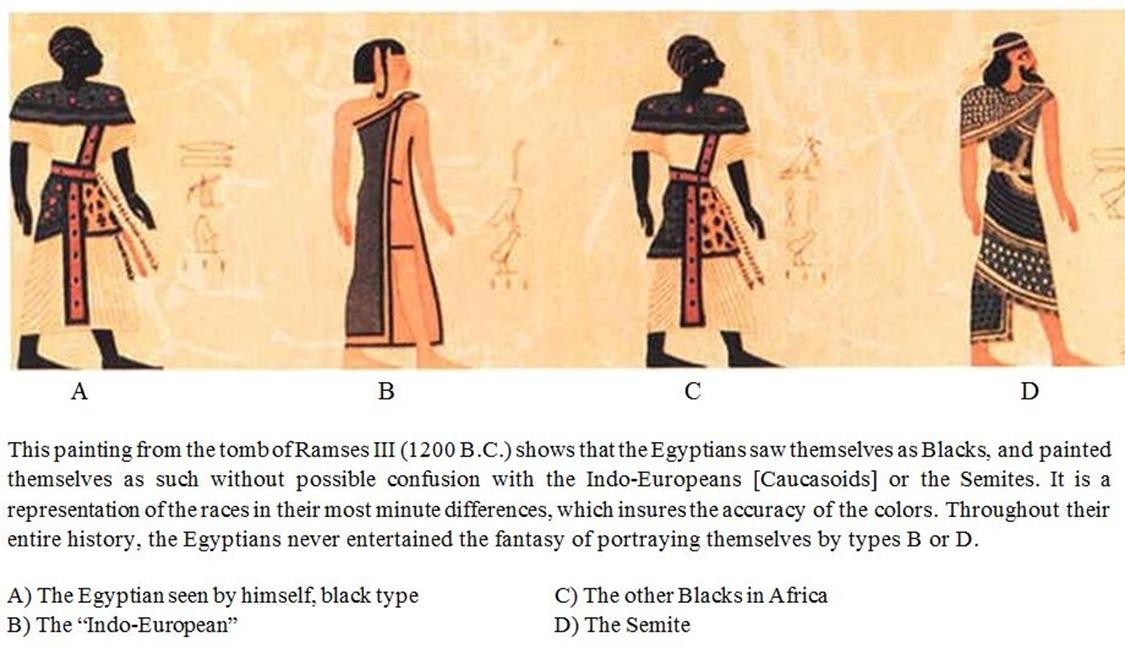
Since there were foreign dynasties that came in with people who do not resemble the native population in the ruling class, the focus will be on the 19th dynasty to a period around 700 B.C when the Ethiopian dynasty, as some Egyptologists refer to it, flourished. At that point there were Kashta, Piankhi (Pi'ankhy), Pharaoh Shabaka called So in the Bible who is wearing a type of leather head dress, and Pharaoh Taharqa. The first two images are of Shabaka or (So), and the last two are of Taharqa.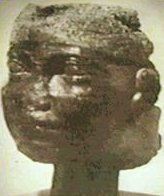
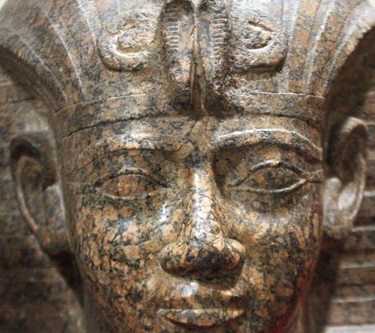
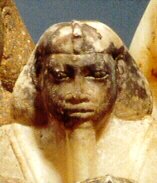
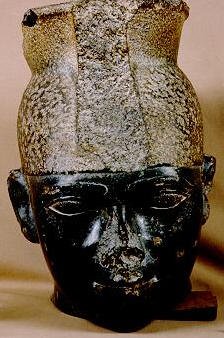
This was an important dynasty called the restoration dynasty, and when you view the facial features, there is overwhelming evidence that clearly show they were Black people.
Van Sertima in his book, "They came Before Columbus" points out that in the 25th dynasty or 700 years B.C which would have been the period before the Greeks and Romans, Shabaka and company were hiring Phoenicians as mercenaries and truck drivers to transport and ship their cargo, but one of the things they also transported was themselves. Van Sertima points out that they ended up in Mexico, thus making a strong case that the 25th dynasty contributed people who had left Egypt and other areas in Afrika, to go to different geographical locations in the world, and Mexico was just one of those places. On the cover of his book he uses the Olmec head that appeared in Mexico at about the time when the 25th dynasty was established.
That image has half a face with an Olmec carving on the right side, and half a face of a Nubian on the left side. In other words, he placed them side by side to show that the Nubians were dressed exactly like the Olmec back then.
Both wore the same type of head dress which was a leather helmet, and the design on the leather helmet was the same as the design on the Olmec head.
Here is a picture of an Olmec head found in Mexico which predates Columbus, with a modern day Nubian woman next to it so that the facial types can be compared to note the similarities. However, there is more than just a physical resemblance as pointed by Ivan Van Sertima. There is a convergence of many lines of data such as linguistic, archaeological, and other kinds that show the direct connection between ancient Egypt and Mexico.
Note that this so called Olmec head not only has an Afrikan appearance, but also what seems to be an afro hair style. Recent discoveries in the field of linguistics and other methods have shown without a doubt that the Ancient Olmecs of Mexico known as the Xi People originally came from West Afrika and were of the Mende Afrikan ethnic stock. The Mende script was discovered on some of the ancient Olmec monuments in Mexico, and was found to be identical to the same script used by the Mende people of West Afrika. Journeys to Mexico and the Southern United States may have taken place from West Afrika much earlier, about five thousand years before Christ. This conclusion is based on the finding of some Afrikan native cotton discovered in North America.
Joe Louis was the nickname given to the Olmec head on the right. The Olmec head on the left is wearing one of those leather helmets, and on close observation, it can be noted that it also has pierced ears just like the Nubians have pierced ears. Ivan Van Sertima however does not profess that the Olmecs were Egyptians; he suggests that the Olmec heads were Egyptian heads, and that a number of these Egyptians most likely mixed with the Olmec population, bringing with them the technical ideas out of Egypt and into that population. It was right after that time that pyramids in Mexico began to spring up which performed the same functions as the pyramids in Egypt. This was also the time period just before and after Christ, that the Greeks and Romans, who were now the dominant forces and in control, started to mummify their bodies.
This is an example of Greco-Roman mummies, the type of mummy that are now seen in the Cairo museum since the Black ones are now hidden from public view, so a visitor visiting the Cairo museum would exclaim, "Oh that's what the Egyptians looked like".
These mummies are representative of what the later Egyptians looked like, the settlers, but that is not what the native Egyptians looked like. Native Egyptians looked like the present Nubian population that is presently in Egypt today.
Here is an example of an image inscribed in the pyramids and temples in Egypt where in the upper right hand corner there is an image of King Tut as a mummy sitting on the left with his uncle Ay holding a stick over his head. His uncle is wearing a leather skinned coat with the tail hanging between his legs. Now the uncle is alive whereas King Tut is dead, so this is a ceremony after the death of a king where the new king is opening the mouth of the mummy. This is what is taking place in the corner. On the near right you can see an Olmec king who is dressed exactly the same way in a leopard skinned coat with a leopard skinned tail hanging between his legs exactly like Pharaoh Ay. Notice that he is also carrying a little stick and a little mummy to his left, which represent the dead king. He is also opening the mouth of that mummy. So here is the exact same ceremonial detail in the Mexican pyramid that exists in the Egyptian one. That was just one of the examples that Dr. Van Sertima put together to point out the identity between those two cultural forms.
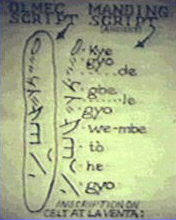
Clyde Winters in one of his articles written for the Journal of Afrikan civilization stated that he had translated the Olmec script which is in fact a Manding script. This script was written and carved into some of the material associated with the stone head, which in reality is an Afrikan or a Manding script that originated directly out of the Egyptian language. There were hieroglyphic writings discovered in America in places like Davenport, Iowa which were there long before the explorers or settlers arrived, again indicating the probable contact between the Egyptians, the Americas and Mexico. The Egyptians therefore did not come from outer space as Erich Von Daniken in his book "Chariot of the Gods" imagined. He actually suggested that at least the Olmec civilization and certain aspects about the pyramids were so high-tech that they could only have been done by aliens from outer space, because these Black Afrikans had no business with this type of technology or knowledge.
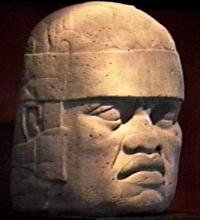
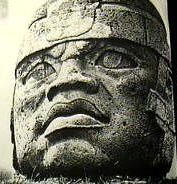
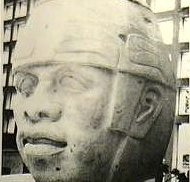
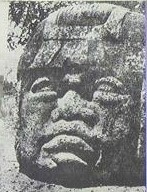
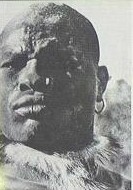
NOTE THE 4 OLMEC HEADS COMPARED TO THE AFRIKAN MAN ON THE RIGHT
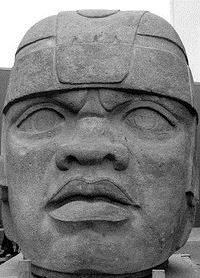
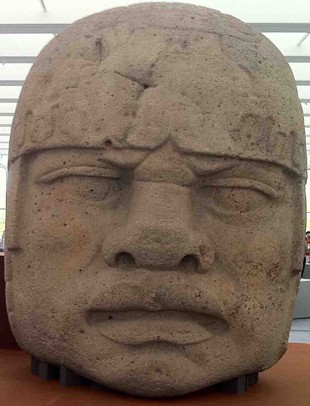
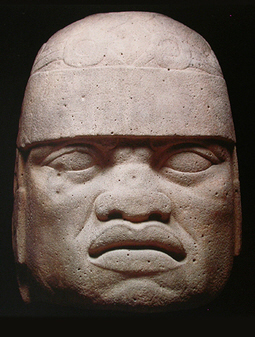
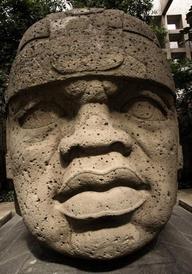
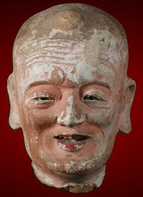
NOTE THE 4 OLMEC HEADS COMPARED TO THE FAKE CHINESE HEAD ON THE RIGHT
The odd head on the extreme right is not an original Olmec, nor were his ancestors, and despite what the archeological community attempts to put forward as factual, the Olmecs were not Asian. All these genuine heads clearly show that they were Black Afrikan.
© John Moore - Barbados, W.I. (March 2000) ©. All rights reserved.
